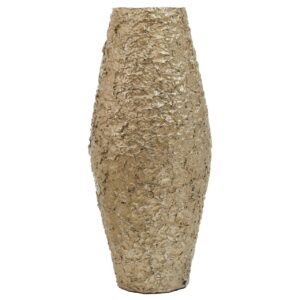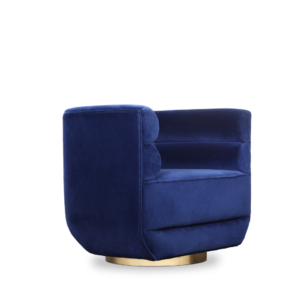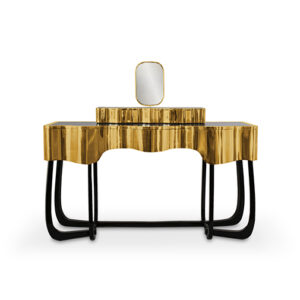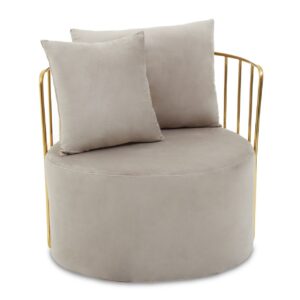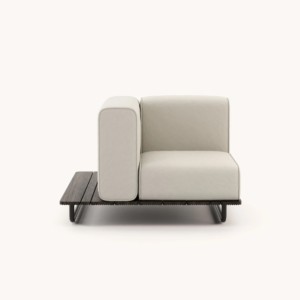Armchair covers serve as both functional protectors and stylish accessories for your beloved armchairs. In today’s bustling households, where spills, pet hair, and everyday wear are inevitable, these versatile covers offer a practical solution to safeguard your furniture investment while adding a touch of flair to your décor. Let’s delve into the world of armchair covers, exploring their purpose, benefits, and how they effortlessly elevate both the look and longevity of your favorite seating.
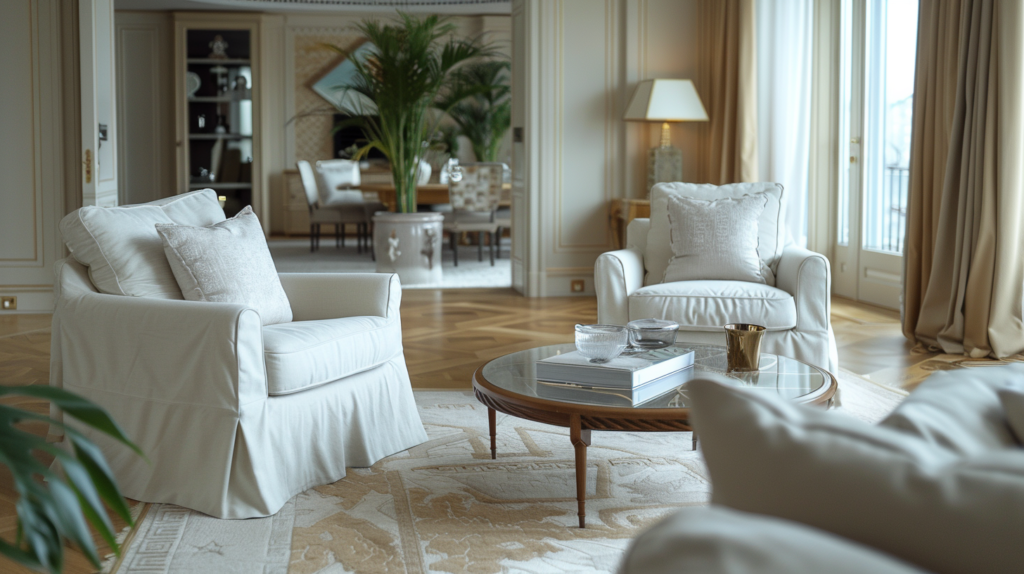
What is an armchair cover?
An armchair cover is a protective fabric or material designed to fit over an armchair, protecting against stains, spills, wear, and tear while also offering a decorative element to enhance the chair’s appearance. An armchair is a type of chair that typically features armrests and a comfortable, upholstered seat and backrest. It is designed for one person and provides a supportive and comfortable seating option, often used in living rooms, lounges, studies, or bedrooms for relaxation or reading. Armchairs come in various styles, sizes, and materials, catering to different preferences and interior design aesthetics.
What is the history of armchair covers?
While the exact origins of armchair covers are not well documented, the practice of covering furniture for protection and decoration dates back centuries. In earlier times, wealthy households often used fabric covers or throws to protect their furniture from dust, dirt, and damage, as well as to showcase their wealth and taste through luxurious textiles. The concept of armchair covers as we know them today likely evolved alongside the development of upholstered furniture in the 17 th and 18 th centuries. As upholstered chairs became more prevalent, especially among the affluent classes, the desire to protect and preserve these valuable pieces of furniture grew. Initially, loose slipcovers made from fabric or tapestry were used to cover chairs, providing both protection and an opportunity for decorative embellishment. Over time, the functionality and design of armchair covers evolved to meet changing needs and preferences. In the 20 th century, with the rise of mass production and modern manufacturing techniques, armchair covers became more accessible to a wider range of consumers. Today, armchair covers are available in a variety of styles, materials, and designs, catering to diverse tastes and lifestyles. While armchair covers may have humble beginnings as practical solutions for protecting furniture, they have also become an integral part of interior design, allowing individuals to easily refresh and update their décor while extending the lifespan of their cherished armchairs.
-

North West
Akola Large Gold Vase
£144 Add to cart -
Sale!

Essential Home
Loren armchair
£2,121 – £2,702 Select options This product has multiple variants. The options may be chosen on the product page -

Brabbu
SINUOUS DRESSING TABLE
£27,796 Add to cart
What are the various forms of armchair covers?
Armchair covers can vary in design and coverage. Some armchair covers only cover the armrests, while others may span across the entire chair, including the seat and backrest. The extent of coverage depends on the specific style and design of the armchair cover, as well as the
preferences of the user. Some covers are designed to fit snugly over the entire armchair, providing comprehensive protection, while others may focus primarily on protecting the armrests while leaving the seat and backrest uncovered. The various forms are listed below:
- Full Coverage Covers: These covers span the entire armchair, including the seat. backrest, and armrests, providing comprehensive protection and a unified look.
- Armrest Covers: Specifically designed to protect just the armrests of the chair, these covers are often used to target areas prone to wear and tear while leaving the rest of the chair uncovered.
- Recliner Covers: Tailored for reclining armchairs, these covers are designed to accommodate the chair’s movement and features, providing both protection and flexibility.
- Stretch Covers: Made from stretchy materials like spandex or elastane, these covers offer a snug fit over the armchair, conforming to its shape and contours for a sleek, tailored look.
- Decorative Throws: While not traditional covers, decorative throws can be draped over armchairs to add a stylish touch while offering some protection against spills and pet hair.
- Customizable Covers: Some manufacturers offer customizable covers where customers can choose the fabric, color, and design details to create a personalized look for their armchair.
- Waterproof or Stain-Resistant Covers: Ideal for households with pets or children, these covers are specially treated to repel liquids and resist stains, making cleanup easier and protecting the armchair from spills.
- Seasonal Covers: Designed for seasonal use, these covers may feature different materials or designs suited to specific weather conditions, such as warmer fabrics for winter or lighter, breathable fabrics for summer.

Materials used in making armchair covers
Armchair covers are made from various materials, each offering unique features and functionalities. Each material offers specific advantages, allowing you to choose the armchair cover that best suits your needs, lifestyle, and aesthetic preferences. These materials include:
- Cotton: Cotton armchair covers are breathable, soft, and comfortable. They are easy to clean and maintain, as most cotton covers are machine washable. However, cotton may wrinkle easily and may not offer as much protection against spills or stains compared to other materials.
- Polyester: Polyester armchair covers are durable, wrinkle-resistant, and often more affordable than natural fiber options. They are also typically stain-resistant and easy to clean, making them ideal for households with children or pets.
- Linen: Linen armchair covers have a luxurious look and feel, with a slightly textured surface and natural sheen. While linen is durable and breathable, it may wrinkle easily and require more maintenance, as it is often dry clean only.
- Velvet: Velvet armchair covers add a touch of elegance and sophistication to any space. Velvet is soft to the touch and has a luxurious appearance, but it may require more careful maintenance to prevent crushing or matting of the fabric.
- Microfiber: Microfiber armchair covers are made from ultra-fine synthetic fibers that mimic the softness of natural fabrics like suede or leather. Microfiber is highly durable, stain-resistant, and easy to clean, making it an excellent choice for busy households.
- Spandex or Elastane: Stretchy materials like spandex or elastane are often blended with other fabrics to create armchair covers that offer a snug, customized fit. These covers are flexible and stretch to accommodate the shape of the chair, providing a sleek and tailored look.
- Waterproof or Water-Resistant Fabrics: Some armchair covers are made from waterproof or water-resistant materials like vinyl or polyester with a waterproof coating. These covers provide extra protection against spills and stains, making them ideal for households with young children or pets.
- Faux Leather or Leatherette: Faux leather or leatherette armchair covers mimic the look and feel of genuine leather but are more affordable and easier to maintain. These covers add a touch of sophistication to any armchair and are typically wipeable for easy cleanup.
-

Brabbu
BATAK BOLD ARMCHAIR
£3,186 – £4,589 Select options This product has multiple variants. The options may be chosen on the product page -

North West
Hansa Two Seat Black Velvet Sofa
£1,100 Add to cart
What factors do I consider before purchasing an armchair cover?
- Size and Fit: Measure your armchair carefully to ensure you select a cover that fits properly. Consider the dimensions of the seat, backrest, and armrests, as well as the overall shape of the chair. Many armchair covers come in standard sizes, but some may offer adjustable straps or elastic edges for a more customizable fit.
- Style and Design: Choose a cover that complements your existing décor and personal style. Consider factors such as color, pattern, and fabric texture to ensure the cover enhances the aesthetic appeal of your space.
- Material: Select a material that suits your lifestyle and preferences. Options range from durable and easy-to-clean fabrics like polyester or microfiber to more luxurious options like velvet or linen. If you have pets or children, consider stain-resistant or waterproof materials for added protection.
- Ease of Maintenance: Check the care instructions for the cover to ensure it is easy to clean and maintain. Machine-washable covers are convenient for regular upkeep, while those requiring dry cleaning or special care may be less practical for everyday use.
- Functionality: Consider how you plan to use the armchair cover. If you need protection against spills or pet hair, opt for a cover with water-resistant or pet-friendly features. For frequent use or reclining chairs, choose a cover with stretchy or adjustable elements for a secure fit.
- Budget: Set a budget for your armchair cover purchase and explore options within your price range. Keep in mind that higher-quality materials and custom features may come at a higher cost but can offer better durability and aesthetics in the long run.
- Installation and Compatibility: Check the installation method of the cover to ensure it is compatible with your armchair. Some covers feature elastic bands, ties, or straps for easy attachment, while others may require more effort to fit properly.
- Reviews and Recommendations: Read reviews from other customers or seek recommendations from friends or family who have experience with armchair covers. Their insights can help you make an informed decision and avoid potential issues with quality or fit.
What are some tips for coordinating armchair covers with other elements of my home
- Color Palette: Choose armchair covers that complement the color palette of your room. Consider selecting covers in shades that match or harmonize with the colors of your curtains, area rugs, walls, and other furniture pieces.
- Pattern Play: If your curtains or area rugs feature patterns, consider selecting armchair covers with complementary or coordinating patterns. Mix and match patterns of varying scales to add visual interest while maintaining balance in the room.
- Texture Variation: Incorporate texture into your décor by choosing armchair covers with interesting textures that complement the textures of your curtains, area rugs, and other furnishings. For example, pair a plush velvet armchair cover with a textured wool rug for a cozy and inviting look.
- Style Consistency: Ensure that the style of your armchair covers aligns with the overall style of your room. Whether your décor is modern, traditional, eclectic, or bohemian, select armchair covers that reflect the same design aesthetic for a cohesive look.
- Accent Colors: Use armchair covers as an opportunity to introduce accent colors into your space. Choose covers in bold or contrasting colors that pick up on accent hues found in your curtains, area rugs, throw pillows, or artwork to create visual cohesion.
- Layering Accessories: Enhance the coordinated look by layering accessories such as throw pillows, blankets, and decorative accents that tie together the colors and patterns of your armchair covers with other elements in the room.
- Consider Proportions: Pay attention to the scale and proportions of your armchair covers in relation to other furnishings in the room. Ensure that the size and shape of your armchairs and covers complement the scale of your curtains, area rugs, and other pieces of furniture for a balanced look.

How do I care for armchair covers?
Caring for armchair covers depends on the material they are made of, but here are some general tips for maintenance:
- Read Care Instructions: Before cleaning your armchair cover, always check the care label or instructions provided by the manufacturer. Different materials may require specific cleaning methods or products.
- Regular Maintenance: Vacuum or shake out your armchair cover regularly to remove dust, crumbs, and pet hair. This helps prevent debris from settling into the fabric and maintains the cover’s appearance.
- Spot Cleaning: For small stains or spills, spot clean the affected area immediately with a mild detergent and warm water. Use a soft cloth or sponge to gently dab the stain, avoiding vigorous rubbing that could damage the fabric.
- Machine Washing: If your armchair cover is machine washable, wash it according to the manufacturer’s instructions. Use a gentle cycle with cold water and mild detergent to prevent shrinking or fading. Avoid using bleach or harsh chemicals that could weaken the fabric.’
- Hand Washing: For delicate fabrics or covers with embellishments, hand wash them in a basin or sink with lukewarm water and a gentle detergent. Gently agitate the fabric and rinse thoroughly to remove soap residue.
- Drying: Air dry your armchair cover whenever possible to avoid shrinking or damage from high heat. Lay the cover flat or hang it to dry, avoiding direct sunlight, which can cause fading. Avoid using a dryer unless the care instructions explicitly state that it is safe to do so.
- Ironing or Steaming: If necessary, iron or steam your armchair cover on a low heat setting to remove wrinkles. Be sure to check the fabric’s care instructions beforehand and use a pressing cloth to protect delicate materials.
- Stain Protection: Consider treating your armchair cover with a fabric protector spray to repel stains and spills. Follow the product instructions carefully and test it on a small, inconspicuous area of the cover first to ensure compatibility.
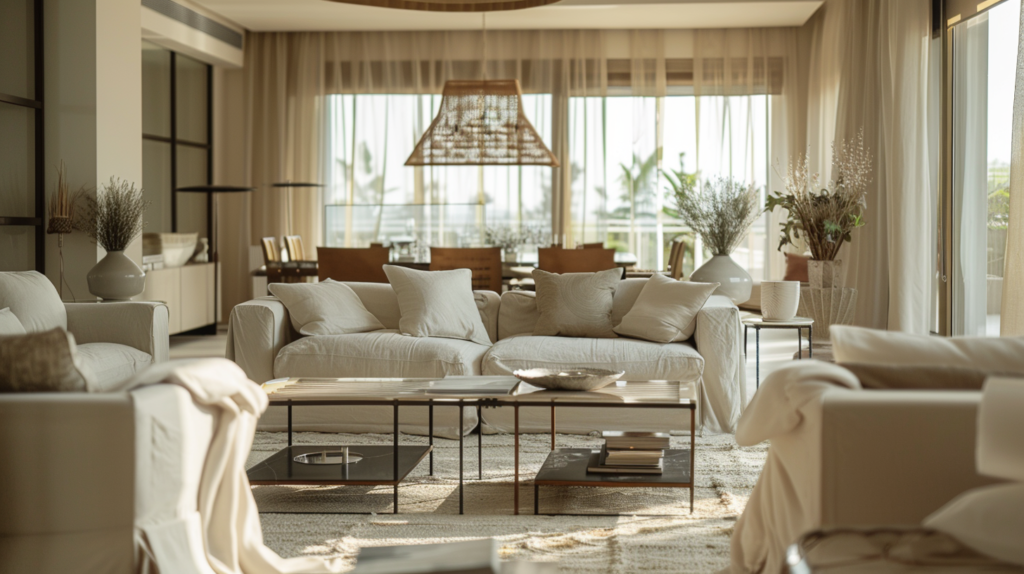
How do I install an armchair cover?
Installing an armchair cover is typically straightforward, but the exact method may vary depending on the design of the cover. Here’s a general guide for installing most armchair covers:
- Prepare the Armchair: Start by removing any throw pillows or accessories from the armchair and straightening out the cushions or seat cover if applicable. Ensure that the
armchair is clean and free of debris to prevent any wrinkles or bumps in the cover. - Position the Cover: Lay the armchair cover flat on the floor or over the back of the chair, depending on its design. Orient the cover so that any straps, ties, or elastic bands are located where they can be easily accessed once the cover is on the chair.
- Fit the Cover Over the Backrest: If the cover has am separate piece for the backrest, start by fitting this portion over the back of the chair. Smooth out any wrinkles or creases and
ensure that the cover is centered and aligned properly. - Fit the Cover Over the Seat: Next, fit the seat portion of the cover over the seat cushion
of the armchair. Tuck the fabric into the crevices between the seat and armrests, ensuring a snug and secure fit. - Secure Straps or Ties: If the cover has straps, ties, or elastic bands, use these to secure the cover in place. Tie or fasten the straps underneath the armchair or around the backrest, depending on the design of the cover, to prevent slipping or shifting.
- Adjust as Needed: Once the cover is in place, adjust it as needed to ensure a smooth and even fit. Smooth out any wrinkles or folds and tuck any excess fabric neatly into the crevices of the armchair for a tailored look.
- Final Touches: Take a step back and inspect the armchair cover from all angles to ensure it is properly installed and looks visually appealing. Make any final adjustments as needed to achieve the desired fit and appearance.
-

North West
Azalea Mink Velvet Chair With Two Pillows
£702 Add to cart -

Domkapa
Copacabana Armchair (Left/Right)
£3,416 – £4,119 Select options This product has multiple variants. The options may be chosen on the product page -

Brabbu
MAA ARMCHAIR
£3,186 – £4,497 Select options This product has multiple variants. The options may be chosen on the product page
In conclusion, armchair covers serve as versatile additions to any interior design scheme, offering both practicality and style in equal measure. From protecting cherished furniture pieces against everyday wear and tear to elevating the aesthetic appeal of living spaces, these covers play a crucial role in enhancing the comfort and visual impact of armchairs. Whether you prefer minimalist elegance, cozy Scandinavian comfort, eclectic mix-and-match, modern glamour, sustainable chic, statement pieces, or a blend of old and new styles, there’s a wide range of armchair covers available to suit every taste and design preference.

